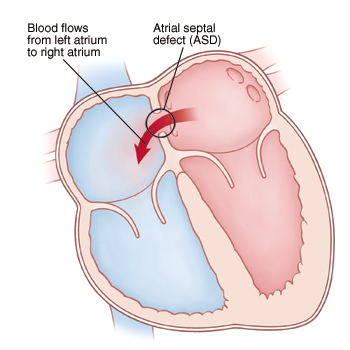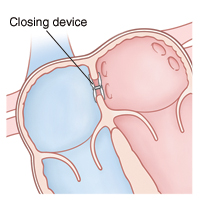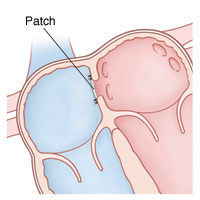Treatment for Your Child’s Atrial Septal Defect (ASD)
Your child has an atrial septal defect (ASD). This is a hole in the dividing wall (atrial septum) between the two upper chambers (atria) of the heart. Your child’s cardiologist has determined that the ASD won’t close on its own and has advised repair. ASD repair is done by putting a closure device in the hole. The device looks like a small, wiry disk with white material in the middle. It can be put in place either with cardiac catheterization or with open heart surgery. Your child’s cardiologist or surgeon will talk with you about the best treatment for your child. In most cases, only an isolated ASD in the center portion of the atrial septum (secundum type ASD) can be closed with cardiac catheterization. All other types of ASDs require open heart surgery.
 |
| An ASD causes more blood than normal to move through the right side of the heart. |
Your child’s experience: cardiac catheterization
Cardiac catheterization is a procedure done on the heart using a thin, flexible tube called a catheter. It’s done by a cardiologist who has extra training to use catheters to treat heart problems. The procedure lasts about 2 to 4 hours. It takes place in a catheterization (cath) lab. You’ll stay in the waiting room during the procedure. Here's what to expect:
-
Before the procedure. You’ll be told to keep your child from eating or drinking anything for a certain amount of time before the procedure. Follow these instructions carefully.
-
During the procedure. Your child is given medicine (sedative or anesthesia). This is to help them relax and not feel discomfort or pain during the procedure. A breathing tube may be put in your child’s windpipe (trachea) during this time. Devices watch your child’s heart rate, blood pressure, and oxygen levels. The catheter insertion site in the groin is cleaned and numbed. Then, the catheter is put into a blood vessel in the groin. With the help of live X-rays, the catheter is moved up through this blood vessel into the heart. Contrast dye may be injected through the catheter. The dye allows the healthcare provider to see the inside of the heart more clearly on X-rays. The wiry disk closure device is put in place to close the ASD. It’s delivered by the catheter and placed across the ASD. Once the cardiologist approves of where the device is placed, it is released from the catheter. Then, the catheter is removed.
-
After the procedure. Your child is taken to a recovery room. You can stay with your child during much of this time. It may take 1 to 4 hours for medicines to wear off. Pressure is put on the catheter insertion site to limit bleeding. A healthcare provider will tell you how long your child needs to lie down and keep the insertion site still. Your child is cared for and watched until they can leave the hospital. Your child will likely need to stay overnight in the hospital.
Risks and possible complications of cardiac catheterization
-
Reaction to contrast dye
-
Reaction to sedative or anesthesia
-
Pain, swelling, redness, bleeding, or fluid leaking at the insertion site
-
Wound infection at insertion site
-
Incomplete closure of the ASD, needing more treatment
-
Abnormal heart rhythm (arrhythmia)
-
Injury to the heart or a blood vessel
-
Unexpected movement of the device (device embolization), which is rare but means the device needs to be removed right away (it may be removed in the cardiac cath lab or with surgery)
Your child’s experience: heart surgery
Heart surgery to repair an ASD is done by a pediatric heart surgeon. The surgery lasts about 2 to 3 hours. It takes place in an operating room in a hospital. You’ll stay in the waiting room during your child’s surgery.
-
Before surgery. You’ll be told to keep your child from eating or drinking anything for a certain amount of time before surgery. Follow these instructions carefully.
-
During surgery. Your child is given medicine (sedative and anesthesia) to sleep and not feel pain during surgery. A breathing tube is put in your child’s windpipe (trachea) during this time. Special equipment monitors your child’s heart rate, blood pressure, and oxygen levels. Your child is also placed on a heart-lung bypass machine. This keeps blood flowing to the body while the heart is stopped so that it can be operated on. The surgeon makes an incision in the chest through the breastbone (sternum) to reach the heart. The ASD is repaired with either stitches or a patch. Then, your child is taken off the bypass machine, and the chest is closed.
-
After surgery. Your child is taken to a critical care unit to be cared for and monitored. Several tubes and wires may be attached to your child. These are in place to help the medical team in caring for your child. You can stay with your child during much of this time. They may remain in the hospital for 3 to 5 days. When your child is ready to leave the hospital, you’ll be given instructions for home care and follow-up. Your child's cardiologist may advise that your child take antibiotics before having dental work. The cardiologist will tell you how long this should continue.
 |
| A device is placed across the septum to close the ASD. |
 |
| A patch is sewn across the ASD to close it. |
Risks and possible complications of heart surgery
-
Reaction to sedative or anesthesia
-
Incomplete closure of the ASD, requiring more treatment
-
Abnormal heart rhythm (arrhythmia)
-
Wound infection
-
Infection
-
Bleeding
-
Nervous system problems, such as seizures or stroke
-
Abnormal buildup of fluid around the heart and lungs
When to call the healthcare provider
After either procedure, call the healthcare provider right away if your child has any of these:
-
Pain, swelling, redness, bleeding, or fluid leaking from an incision or insertion site that gets worse
-
A fever (ask the healthcare team what temperatures to be concerned about)
-
Trouble feeding
-
Increased tiredness
-
Nausea or vomiting that continues
-
A cough that won’t go away
Call 911 if your child has any of these:
Online Medical Reviewer:
Dan Brennan MD
Online Medical Reviewer:
Stacey Wojcik MBA BSN RN
Date Last Reviewed:
3/1/2025
© 2000-2025 The StayWell Company, LLC. All rights reserved. This information is not intended as a substitute for professional medical care. Always follow your healthcare professional's instructions.